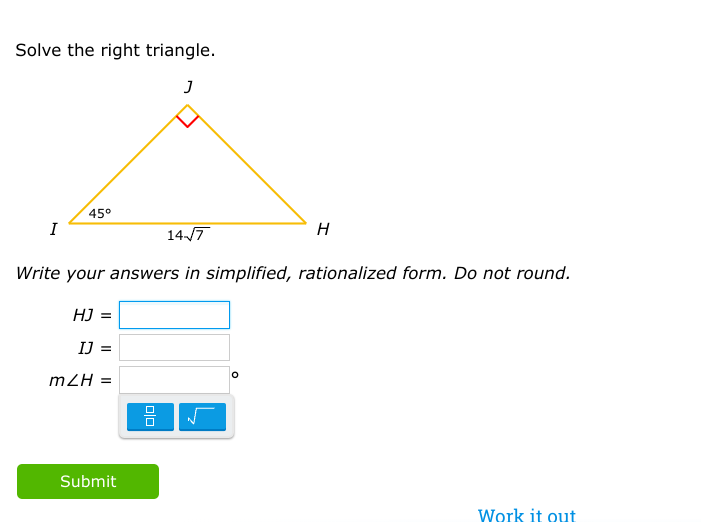Solve the right triangle. Write your answers in simplified, rationalized form. HJ =, IJ =, m∠H = °

Understand the Problem
The question is asking to solve a right triangle where one angle is given as 45 degrees, and one side's length is provided as 14/√7. The user needs to find the lengths of the other sides and the measure of the remaining angle in simplified and rationalized form.
Answer
- \( HJ = \frac{7\sqrt{14}}{14} \) - \( IJ = 7\sqrt{\frac{2}{7}} \) - \( m\angle H = 45° \)
Answer for screen readers
- ( HJ = \frac{7\sqrt{14}}{14} )
- ( IJ = \frac{14\sqrt{2}}{2\sqrt{7}} = 7\sqrt{\frac{2}{7}} )
- ( m\angle H = 45° )
Steps to Solve
-
Identify Angles in the Triangle
In a right triangle, the sum of all angles equals 180 degrees. We have one angle of 45 degrees and one right angle (90 degrees). Therefore, the remaining angle ( m\angle H ) can be calculated as:
$$ m\angle H = 180° - 90° - 45° = 45° $$ -
Determine the Lengths of the Sides
Since ( HJ ) is opposite ( \angle I ) (which is 45 degrees) and ( IJ ) is adjacent to it, we can use the sine function to find ( HJ ):
$$ HJ = IH \cdot \sin(45°) $$
Substituting ( IH = \frac{14}{\sqrt{7}} ):
$$ HJ = \frac{14}{\sqrt{7}} \cdot \sin(45°) $$
Since ( \sin(45°) = \frac{\sqrt{2}}{2} ), we have:
$$ HJ = \frac{14}{\sqrt{7}} \cdot \frac{\sqrt{2}}{2} = \frac{14\sqrt{2}}{2\sqrt{7}} = \frac{7\sqrt{2}}{\sqrt{7}} = 7\sqrt{\frac{2}{7}} = \frac{7\sqrt{14}}{14} = \frac{\sqrt{14}}{2} $$ -
Calculate the Other Side Length (IJ)
Using the cosine function, we can determine side ( IJ ):
$$ IJ = IH \cdot \cos(45°) $$
Substituting ( IH = \frac{14}{\sqrt{7}} ):
$$ IJ = \frac{14}{\sqrt{7}} \cdot \cos(45°) $$
And since ( \cos(45°) = \frac{\sqrt{2}}{2} ):
$$ IJ = \frac{14}{\sqrt{7}} \cdot \frac{\sqrt{2}}{2} = \frac{7\sqrt{2}}{\sqrt{7}} = 7\sqrt{\frac{2}{7}} = \frac{7\sqrt{14}}{14} = \frac{7\sqrt{14}}{14} $$
- ( HJ = \frac{7\sqrt{14}}{14} )
- ( IJ = \frac{14\sqrt{2}}{2\sqrt{7}} = 7\sqrt{\frac{2}{7}} )
- ( m\angle H = 45° )
More Information
In this right triangle, both angles ( I ) and ( H ) are ( 45° ), making it an isosceles triangle. This symmetry allows for both sides ( HJ ) and ( IJ ) to have equal lengths when the provided side (in this case ( IH )) is the same.
Tips
- Confusing the sine and cosine functions, which would lead to incorrect side lengths.
- Forgetting that angles in a triangle add up to 180 degrees can lead to incorrect angle measures.
AI-generated content may contain errors. Please verify critical information